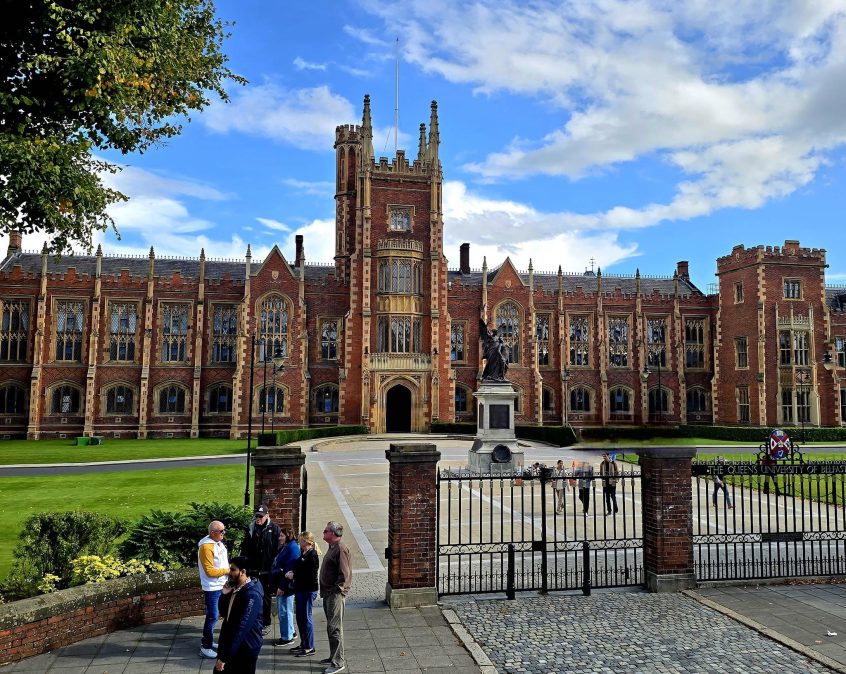This morning, I boarded a bus in Letterkenny that went directly to Belfast. Today this route is straightforward, there are no indications that we crossed from the Republic of Ireland to Northern Ireland. Thanks to the Good Friday Agreement (1998) and the removal of military checkpoints, the political tension that once made this journey scary and potentially dangerous is largely gone.
During the Troubles, that same trip meant passing through heavily policed or military checkpoints, with soldiers, barbed wire, and vehicle searches a normal part of crossing. What was once a symbol of division is now an almost invisible line. From what I have read, there are still sensitivities, but in daily life the barrier is hardly noticeable.
But there are very definite differences. For one thing, the currency in the Irish Republic is the Euro. In Northern Ireland it is the British pound. British flags fly everywhere, and monuments and posters of the royal family abound. Walking around downtown, I felt as though I was in England. Many of the popular British chain stores are present: Boots, Marks and Spencer, Tesco, Sainsbury’s and more.
As I usually do when I arrive in a new city, I took a hop-on-hop-off bus for an overview. From the open-top deck, my first view was the grand sweep of Donegall Square, with City Hall anchoring the center. While I waited for the bus to depart, I saw Belfast’s mix of old and new: ornate Victorian banks now turned into cafés, and sleek glass towers glinting in the sunshine. Of course, the sunshine didn’t last, I don’t think there is ever a day when rain doesn’t make an appearance. Fortunately today’s shower was brief.
That mix of old and new was all around us as we took off to see the city. The bus crossed over the River Lagan towards the Titanic Quarter. The shipbuilding industry was huge during the early 20th century, along with linen mills and other manufacturing factories.
Locals are IMMENSELY proud of the fact that the Titanic was built here, despite its sad ending. As the tour guide said, locals like to say it was in great shape when it left here. Everyone who has been to Belfast has told me the Titanic Museum is a must see. I plan to go tomorrow.
On the way back across the river the guide pointed out a new sculpture known as the “Beacon of Hope.” The figure reaches skyward, holding a globe aloft. The guide told us that almost none of the locals call the sculpture by its official name, preferring the Hula Hoop Girl or the Thing with the Ring.
We next headed toward the Cathedral Quarter, where vivid street art splashes across brick walls and alleys. In fact, there is street art everywhere! I look forward to discovering more of it over the next few days. This part of the city hums with energy—pubs, galleries, and restaurants. It’s the center of Belfast’s nightlife.
Then, the tone changed as we approached the peace walls. These aren’t small neighborhood dividers, but massive structures—some up to twenty-five feet tall—originally built by the British Army to separate Catholic and Protestant communities during the Troubles.
Even now, decades after the Good Friday Agreement, the gates are still closed at night. From the top deck I saw the murals that blanket the walls, telling stories of resistance, loyalty, and loss. What I found especially interesting is that the murals don’t just tell about Belfast’s troubles, but about political strife around the globe. There were loads of recently painted murals about Gaza. Looking at the murals, I felt a heaviness in my heart. It’s one thing to read about division; it’s another to see it literally painted across concrete, towering over the streets people call home.
In Belfast, the city’s two communities, Nationalists and Unionists (often called Loyalists), live side by side yet apart. Nationalist areas are draped in the green, white, and orange of the Irish tricolor, with murals honoring Irish heroes and calls for unity with the Republic. When we crossed into a Unionist neighborhood the tone shifted. The Union Jack flies from lampposts, walls are emblazoned with images of kings, queens, and military regiments, and loyalty to Britain is proclaimed everywhere.
What struck me most was how quickly the scenery changed—one turn of the bus and the flags, colors, and murals shifted, like stepping from one world into another. It was a reminder that while the Troubles may be over, the legacy of identity still runs strong. Yet alongside these sharp divides, I also noticed ordinary life in both neighborhoods. Kids kicked footballs, mothers pushed carriages, friends chatted at bus stops. Those glimpses softened the edges of division and reminded me that, beneath the banners and symbols, people here are simply living their daily lives.
The bus returned me to City Hall. I wandered into the park surrounding the building and then went inside. I was totally surprised by the interior. The dome is impressive, but even more impressive are the stained-glass windows. They portray everything from gay rights / pride to depictions honoring those who died during the famine, to celebrating the dock workers, and other historical events. There’s also a huge exhibition about the city’s history.
At that point I was exhausted and returned to my hotel. An unplanned four-hour nap ate up my evening.

